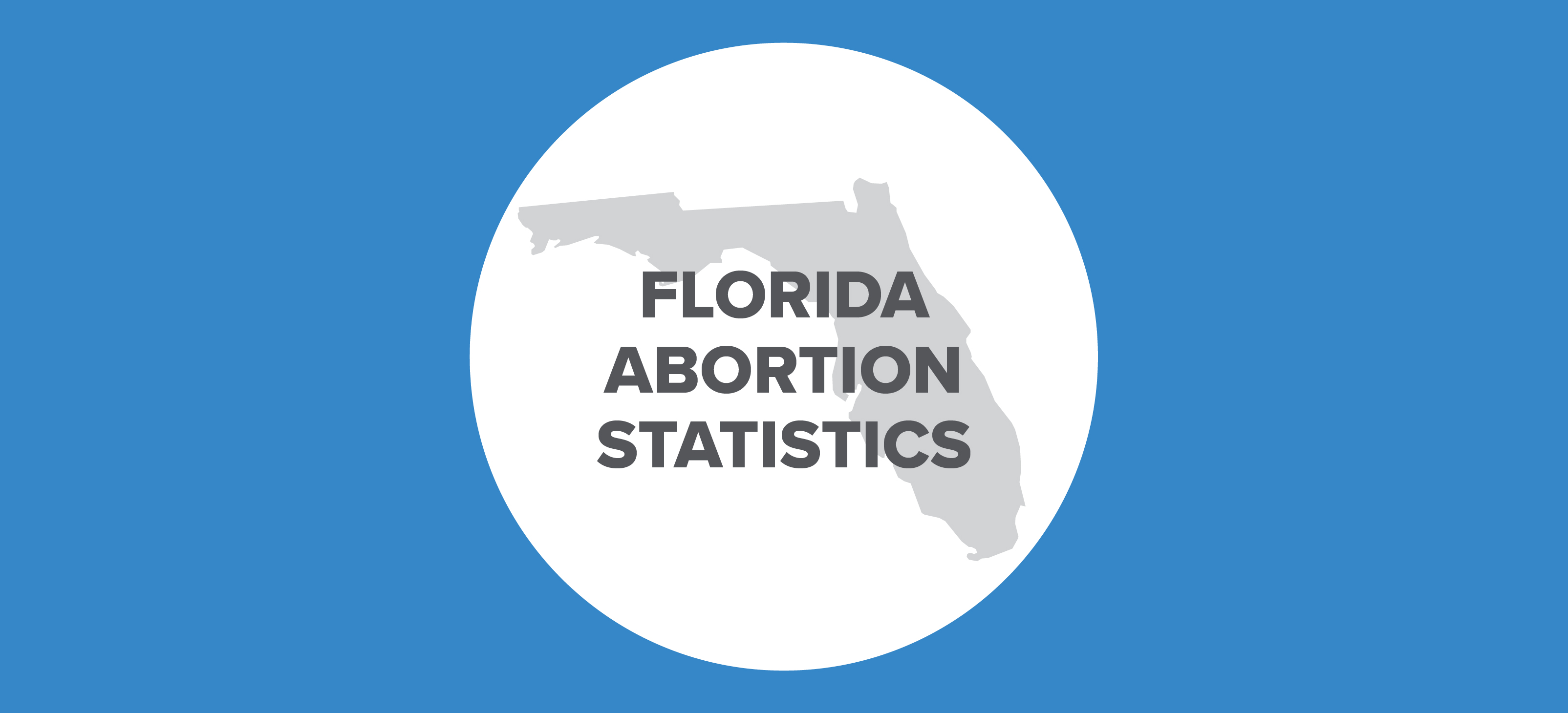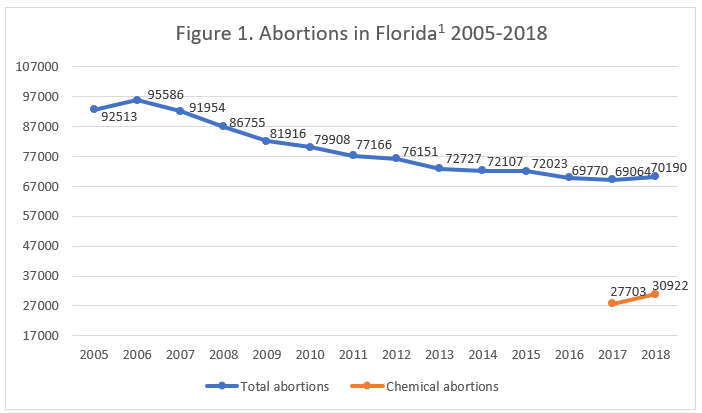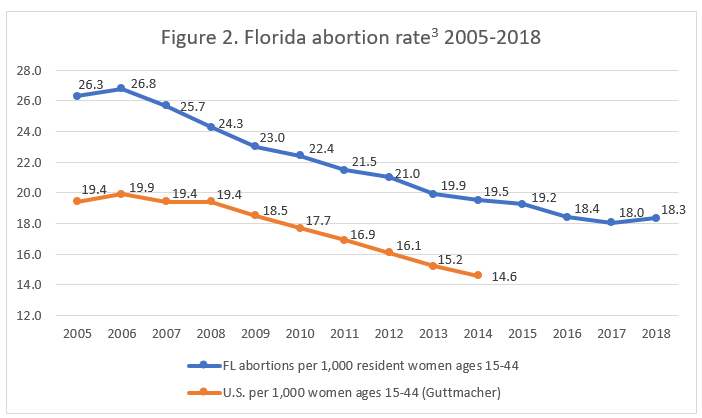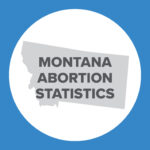Abortion Reporting: Florida (2018)

Author’s Note (September 2019): This article has been updated to reflect Florida’s legal definition of “gestation” to be equivalent to post-fertilization age.
Florida is one of the first states to publish its abortion statistics each year. Some tables are available on the website of the Florida Agency for Health Care Administration, while others were provided to the Charlotte Lozier Institute upon request.
Changes in Florida Abortions, 2017-2018

Abortion Totals and Trends
In 2018, there were 70,190 abortions reported in Florida1 (Fig. 1). After declining for more than a decade, abortions increased by not quite two percent between 2017 and 2018. Still, abortions in Florida are 27 percent lower than the 95,586 reported in 2006, the highest total on record in Florida. As in other states, chemical abortions are on the rise: chemical abortions increased by 12 percent from 27,703 in 2017 to 30,922 in 2018. Chemical abortions made up 44 percent of total Florida abortions in 2018. The Charlotte Lozier Institute estimates that Florida’s 2018 abortion rate was 18.3 abortions per 1,000 women of childbearing age (Fig. 2).
State Report Summary
Ninety-six percent of the abortions reported in Florida were performed on state residents. Eight percent were performed on women under the age of 20. Fifty-six percent were performed on women in their twenties, 31 percent on women in their thirties, and four percent on women age 40 or older. Just over half of the women were white (51 percent), while 34 percent were black and nine percent were of a different race. The race of the mother was unknown for seven percent of the abortions.
Seventy-four percent of the abortions were performed on unmarried women and 14 percent on married women, although marital status was unknown for 13 percent of the women. More than half (56 percent) had no prior abortions. A quarter had one previous abortion, and 19 percent had two or more. Thirty-seven percent had no prior live births, 26 percent had one prior live birth, and another 37 percent had more than one.
Seventy-two percent of the abortions reported in Florida occurred at six weeks post-fertilization or earlier (approximately eight weeks of gestation), and an additional 13 percent were performed between seven and eight weeks post-fertilization. Six percent occurred between nine and 10 weeks, and three percent were performed between 11 and 12 weeks. Two percent were performed between 13 and 14 weeks, and an additional two percent were performed between 15 and 17 weeks post-fertilization. There were 692 abortions (almost one percent of the total) performed between 18 and 20 weeks post-fertilization, while another 213 abortions (0.3 percent) were performed at 21 weeks post-fertilization or later. Florida’s abortion reporting refers to gestational age, but the state defines gestational age to be equivalent to post-fertilization age and asks providers to report abortions using post-fertilization age.
The most common abortion method was curettage, used in 51 percent of the abortions performed in Florida. Forty-four percent were chemical abortions. There were five hysterectomy/hysterotomy abortions and two intrauterine instillation abortions reported in 2018. The type of procedure used was not reported for five percent of the abortions.
Six babies were born alive during abortions in 2018. Florida’s reports do not say what happened to the babies after they were born.
Reasons for Abortion
Florida made major updates to its abortion reporting system in 2017. Prior to 2017, doctors submitted a summary report each month, providing the state health department with the total number of abortions performed for each reason. Under the new system, doctors start a new case report for each abortion they perform. Every month, the case reports are sent to the health department. It appears that the new case-based reporting system has impacted the precision with which reasons for abortions are reported.2
Florida sorts reasons for abortions into eight general categories: life of the mother; physical health of the mother; emotional or psychological health of the mother; abnormality in the baby; rape; incest; social or economic concerns; and elective. The percentage of elective abortions as defined has fallen from 2016. In 2016, elective abortions made up 92 percent of all abortions reported in Florida. In 2017, elective abortions fell to 80 percent of the total, and in 2018, elective abortions made up just 75 percent of all abortions in Florida. Meanwhile, the percentage of abortions performed for most other reasons has increased.
Abortions performed for the cited reason of social and economic concerns increased from six percent of the total in 2016 to 16 percent in 2017 and 20 percent in 2018. Abortions citing the mother’s emotional or psychological health climbed from 0.1 percent in 2016 to 1.3 percent in 2017 and 1.7 percent in 2018. Similarly, abortions categorized as due to the mother’s physical health jumped from 0.1 percent in 2016 to one percent in 2017 and 1.5 percent in 2018.
While still making up a small fraction of all abortions, abortions performed because of risk to the mother’s life, an abnormality in the baby, and a pregnancy resulting from incest also rose as a percent of the whole. Abortions because the mother’s life was in danger increased from 0.02 percent in 2016 to 0.2 percent in 2017 and 0.3 percent in 2018. Abortions due to an abnormality rose from 0.7 percent in 2016 to 0.9 percent in 2017 and one percent in 2018. Between 2009 and 2016, just three abortions were performed because of incest; in 2017, five abortions were performed due to incest, and in 2018, there were eight abortions because of incest. The only reason that showed little change was rape: abortions due to rape composed 0.1 percent of the total in 2018 but have fluctuated from 0.08 percent (2015) to 1.6 percent (2012) of all abortions reported in Florida.
The shift in reported reasons for abortions emphasizes how blurry and ill-defined the boundaries between “elective” and “medically necessary” abortions can be. As CLI Vice President and Director of Data Analytics Dr. James Studnicki points out in a recent editorial, the term “medically necessary” has been rendered basically meaningless in the context of abortion. Florida’s new abortion reporting system enables greater accuracy and precision, but it also illustrates that the difference between an elective abortion and one performed for a different reason, such as social concerns, can be arbitrary.
State Ranking
In 2016, the Charlotte Lozier Institute surveyed abortion reporting across the 50 states, New York City, and the District of Columbia. Florida was ranked at 40th place for the quality of its reporting. Florida has made great improvements to its abortion reporting since then. The state now collects and publishes basic demographic information as well as the types of procedures used to perform abortions. However, Florida could improve its reporting by including information on the care given to babies who are born alive during abortions and whether the babies survive and for how long. Florida could also include information on its informed consent and parental notification processes and the types of facilities where abortions are performed. Additionally, Florida could report the level of education of women who get abortions and report race with more specificity. Florida could make its reports more accessible by posting all tables online. Still, Florida’s new reporting process is a strong step in the right direction.


- The totals for 2017 shown here do not match previous CLI articles because Florida updated its 2017 statistics after CLI’s article was published. 2018 abortion totals may be updated slightly in future reports.
- Data on reasons for abortion has not been completely finalized for 2018 and is missing 107 abortions.
- Starting with the 2018 abortion reports, rates are calculated by the Charlotte Lozier Institute to allow for easier state-to-state and year-to-year comparisons. Rates were calculated by CLI using population estimates from the United States Census Bureau. The rates were calculated using the following formula: (total number of abortions performed in Florida ÷ number of resident women ages 15-44) x 1,000. Rates differ slightly from previous CLI articles due to revised population estimates.
Click here to view reporting from:a class=”a-reporting” href=”https://lozierinstitute.org/abortion-reporting-florida-2023/”>202320222021202020192017

























